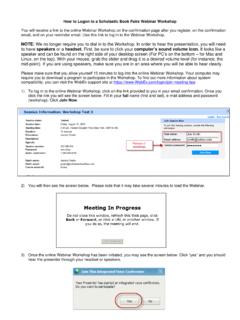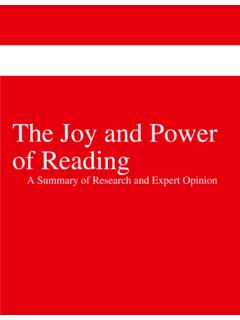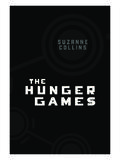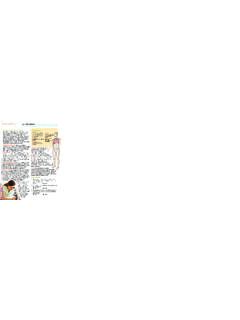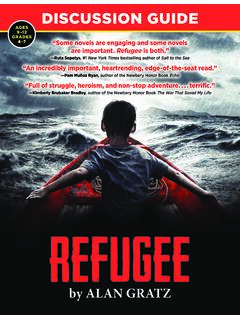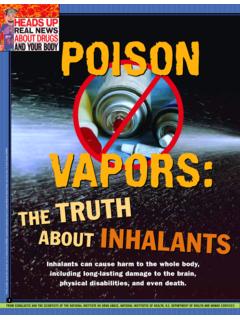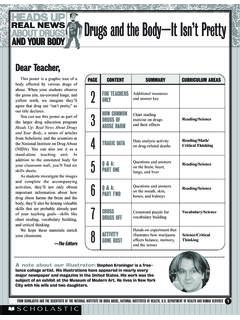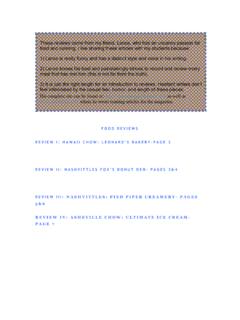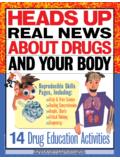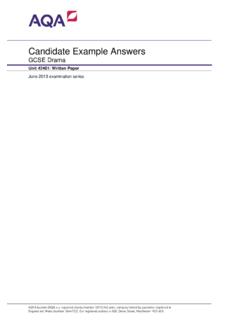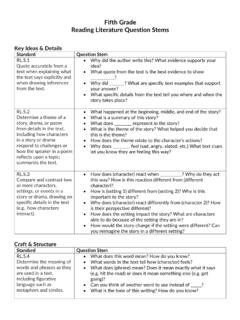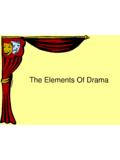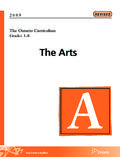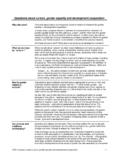Transcription of Fourth Grade Reading Literature Question Stems - …
1 Fourth Grade Reading Literature Question Stems Key Ideas & Details Standard Question stem Refer to details and examples in a text when explaining what the text says explicitly and when drawing inferences from the text. Why did the author write this? What evidence supports youridea? What is the best evidence to show _____? Why did _____? What examples from the story support thereason? Why did (event) happen? How do you know? What does (character) think about (event)? How do you know? What do you think (character) will do differently next time? Explain why (character or object) is important to the Determine a theme of a story, drama , or poem from details in the text; summarize the text. What happened at the beginning, middle, and end of the story?
2 What is a summary of this story? What is the lesson you should learn from this story? What is this story trying to teach? What does _____ represent in the story? Describe in depth a character, setting, or event in a story or drama , drawing on specific details in the text ( , a character's thoughts, words, or actions). How does (character) feel at this part of the story? How do youknow? How does (character) actions change what happens in the story?How would the story be different without them? What problem does (character) have in the story? How does he/she solve their problem? How is (character) different at the end of the story then at thebeginning? How does (character) react when _____? Why does he/she act this way?
3 How does (character) change throughout the story? What are (character) personality traits? How does his/her personality affect what happens in the story? Why is the setting important to the story? Why does the authoruse this setting? How does the character use the features of the setting to helpthem?Craft & Structure Standard Question stem Determine the meaning of words and phrases as they are used in a text, including those that allude to significant characters found in mythology ( , Herculean). What does this word mean? How do you know? What words in the text tell how (character) feels? What does (phrase) mean? Does it mean exactly what it says( hit the road) or does it mean something else ( getgoing)?
4 Can you think of another word to use instead of _____? What is the tone of this writing? How do you know? Why did the author choose (rhyming words, alliteration,repeated lines)? How does that make the Reading different? Why did the author choose this word? What does _____ mean? Examples from mythology include having the Achilles heel, herculean effort, Pandora s box, Trojan Explain major differences between poems, drama , and prose, and refer to the structural elements of poems ( , verse, rhythm, meter) and drama ( , casts of characters, settings, descriptions, dialogue, stage directions) when writing or speaking about a text. How are the parts of the story connected? How does thissection/chapter help the reader understand the setting?
5 How does this scene build suspense? How would you retell this story, including important parts fromthe beginning, middle, and end? In poetry what stanza is the most interesting to you? Why? Why did the author organize the story like this? How would itbe different if the order were changed? In drama how does this structure help you understand what is going on? What helps you picture the story? Compare and contrast the point of view from which different stories are narrated, including the difference between first- and third-person narrations. Who is telling this story? How do you know? Are the narrator and the author the same person? How do youknow? What point of view is this written from? What does (character/narrator) think of (event/action)?
6 Whatdo you think? What would you have done differently?Integration of Ideas & Knowledge Standard Question stem Make connections between the text of a story or drama and a visual or oral presentation of the text, identifying where each version reflects specific descriptions and directions in the text. What does this illustration show? What was different when you read the drama and when yousaw the drama (either live or video)? The story says (insert quote). Where do you see that happeningin the illustrations? How is the story the same as the film? How is it different?Which do you prefer and why? Not applicable for Literature Compare and contrast the treatment of similar themes and topics ( , opposition of good and evil) and patterns of events ( , the quest) in stories, myths, and traditional Literature from different cultures.
7 How does (version 1) differ from (version 2) of this story? How are the versions the same? How did the theme/setting/plot of the different stories stay the same? What is different? Which text was better at getting the point/lesson/point of view across? Why did you like it better? How did the characters solve problems in the same way? How were the solutions different? Fourth GradeReading Information Question Stems Key Ideas & Details Standard Question stem Refer to details and examples in a text when explaining what the text says explicitly and when drawing inferences from the text. What evidence can you find to show _____? Based on the information, which _____ (action is best, dealis better, argument is most likely)?
8 Who / What / Where / When / Why questions such as:oWho (action first landed on the moon)? Where doesit tell you that in the book?oWhere (do clown fish live)? Where does it tell you that inthe book? How questions such as:oHow do you know whales are mammals?oHow is a lizard like an alligator? What evidence in the text proves _____? Determine the main idea of a text and explain how it is supported by key details; summarize the text . What is the main idea of the entire passage? What details tellmore about that idea? What is the main idea of just this paragraph? What detailssupport the main idea? Why is _____ a good title for this article? How do the detailssupport this being a good title? If you were going to make a new title, what would it be?
9 Whatdetails gave you the idea for that title? What do you think the author wants the readers to know? Summarize the information in a few Explain events, procedures, ideas, or concepts in a historical, scientific, or technical text, including what happened and why, based on specific information in the text. What are the most important events/ideas/steps to remember?Why are those the most important? What caused (event)? What effect did (event) have? What is the effect of _____? How did the (person/animal/item) change? How did (experiences) lead to (achievement)? What happens right before _____? What would happen if you left out this step? How are _____ and _____ the same? How are they different?What text evidence supports your answer?
10 Craft & Structure Standard Question stem Determine the meaning of general academic and domain-specific words or phrases in a text relevant to a Grade 4 topic or subject area. How do the words and images show (vocabulary word)? What does the word _____ mean? How did the other words help you figure out the meaning? Are there any words that confuse you? What helps you understand the meaning of _____? What is a synonym for the word _____? How do you know? What does _____ mean as it is used here? What other meanings are there for the same word? Describe the overall structure ( , chronology, comparison, cause/effect, problem/solution) of events, ideas, concepts, or information in a text or part of a text.
